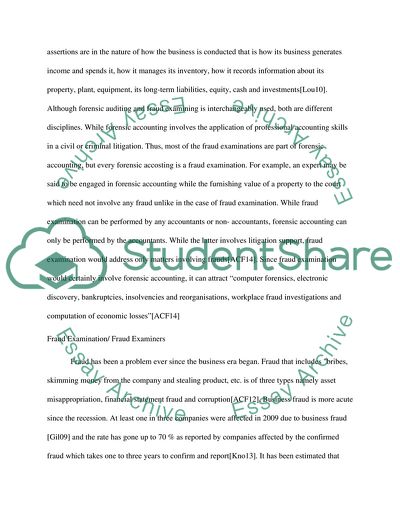Cite this document
(“External Auditors and Fraud Examiners Essay Example | Topics and Well Written Essays - 3500 words”, n.d.)
External Auditors and Fraud Examiners Essay Example | Topics and Well Written Essays - 3500 words. Retrieved from https://studentshare.org/finance-accounting/1854825-external-auditors-and-fraud-examiners-a-critical-evaluation-of-the-differences-in-skills-sets-and-task-objectives-note-in-addition-to-highlighting-the-skills-and-task-objectives-make-sure-that-the-main-part-of-the-essay-is-a-critical-evaluation-betwe
External Auditors and Fraud Examiners Essay Example | Topics and Well Written Essays - 3500 words. Retrieved from https://studentshare.org/finance-accounting/1854825-external-auditors-and-fraud-examiners-a-critical-evaluation-of-the-differences-in-skills-sets-and-task-objectives-note-in-addition-to-highlighting-the-skills-and-task-objectives-make-sure-that-the-main-part-of-the-essay-is-a-critical-evaluation-betwe
(External Auditors and Fraud Examiners Essay Example | Topics and Well Written Essays - 3500 Words)
External Auditors and Fraud Examiners Essay Example | Topics and Well Written Essays - 3500 Words. https://studentshare.org/finance-accounting/1854825-external-auditors-and-fraud-examiners-a-critical-evaluation-of-the-differences-in-skills-sets-and-task-objectives-note-in-addition-to-highlighting-the-skills-and-task-objectives-make-sure-that-the-main-part-of-the-essay-is-a-critical-evaluation-betwe.
External Auditors and Fraud Examiners Essay Example | Topics and Well Written Essays - 3500 Words. https://studentshare.org/finance-accounting/1854825-external-auditors-and-fraud-examiners-a-critical-evaluation-of-the-differences-in-skills-sets-and-task-objectives-note-in-addition-to-highlighting-the-skills-and-task-objectives-make-sure-that-the-main-part-of-the-essay-is-a-critical-evaluation-betwe.
“External Auditors and Fraud Examiners Essay Example | Topics and Well Written Essays - 3500 Words”, n.d. https://studentshare.org/finance-accounting/1854825-external-auditors-and-fraud-examiners-a-critical-evaluation-of-the-differences-in-skills-sets-and-task-objectives-note-in-addition-to-highlighting-the-skills-and-task-objectives-make-sure-that-the-main-part-of-the-essay-is-a-critical-evaluation-betwe.


